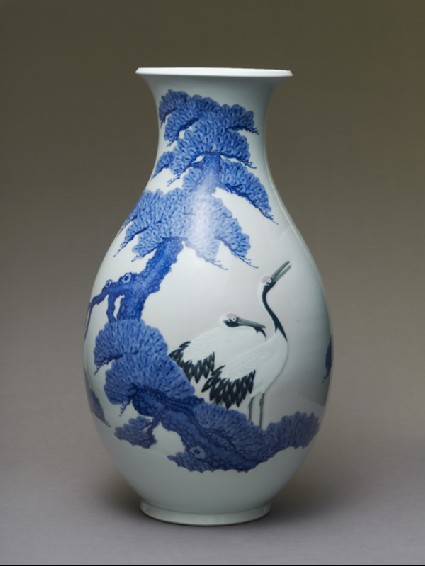Browse: 87 objects
- Reference URL
Actions
Inverted baluster vase with two cranes
-
Details
- Associated place
-
Asia › Japan › Honshū › Kyōto prefecture › Kyoto (Seifū kiln-site) (place of creation)
- Date
-
c. 1910
Meiji Period (1868 - 1912)
- Artist/maker
-
Seifū Yohei III (1851 - 1914) (potter)
- Material and technique
- porcelain, with modelled slip decoration, and underglaze painting in blue, black, pink, and yellow
- Dimensions
-
44 cm (height)
24 cm (diameter)
- Material index
- Technique index
- Object type index
- No. of items
- 1
- Credit line
- Purchased with the assistance of the Story Fund, 1993.
- Accession no.
- EA1993.399
-
Further reading
Impey, Oliver, and Joyce Seaman, Japanese Decorative Arts of the Meiji Period 1868-1912, Ashmolean Handbooks (Oxford: Ashmolean Museum, 2005), no. 15 on p. 34, illus. pp. 34-35
Pollard, Clare, Master potter of Meiji Japan: Makuzu Kōzan (1842-1916) and his Workshop, Oxford Oriental monographs (Oxford: Oxford University Press, 2002), p. 72, pl. 29
Glossary (3)
porcelain, slip, underglaze painting
-
porcelain
Ceramic material composed of kaolin, quartz, and feldspar which is fired to a temperature of c.1350-1400⁰c. The resulting ceramic is vitreous, translucent, and white in colour.
-
slip
A semi-fluid clay applied to a ceramic before glazing either to coat the surface or for decorative effect.
-
underglaze painting
Painting applied to ceramic material before a transparent, or monochrome or coloured glaze for Islamic objects, is applied. The technique was initially developed in China.
Location
-
- currently in research collection
Objects are sometimes moved to a different location. Our object location data is usually updated on a monthly basis. Contact the Jameel Study Centre if you are planning to visit the museum to see a particular object on display, or would like to arrange an appointment to see an object in our reserve collections.
Publications online
-

Japanese Decorative Arts of the Meiji Period
Tall inverted baluster vase with low relief moulding of two cranes in colours on an underglaze blue pine tree, with a pink and white ground. Incised signature on base within two underglaze blue circle: Dai Nihon Seifū zō.
Seifū I had been a pupil of Nin'ami Dōhachi [see EA2000.181] in Kyōto; the family kiln was set up in Gojōzaka. This is an unusually showy piece.
© 2013 University of Oxford - Ashmolean Museum









